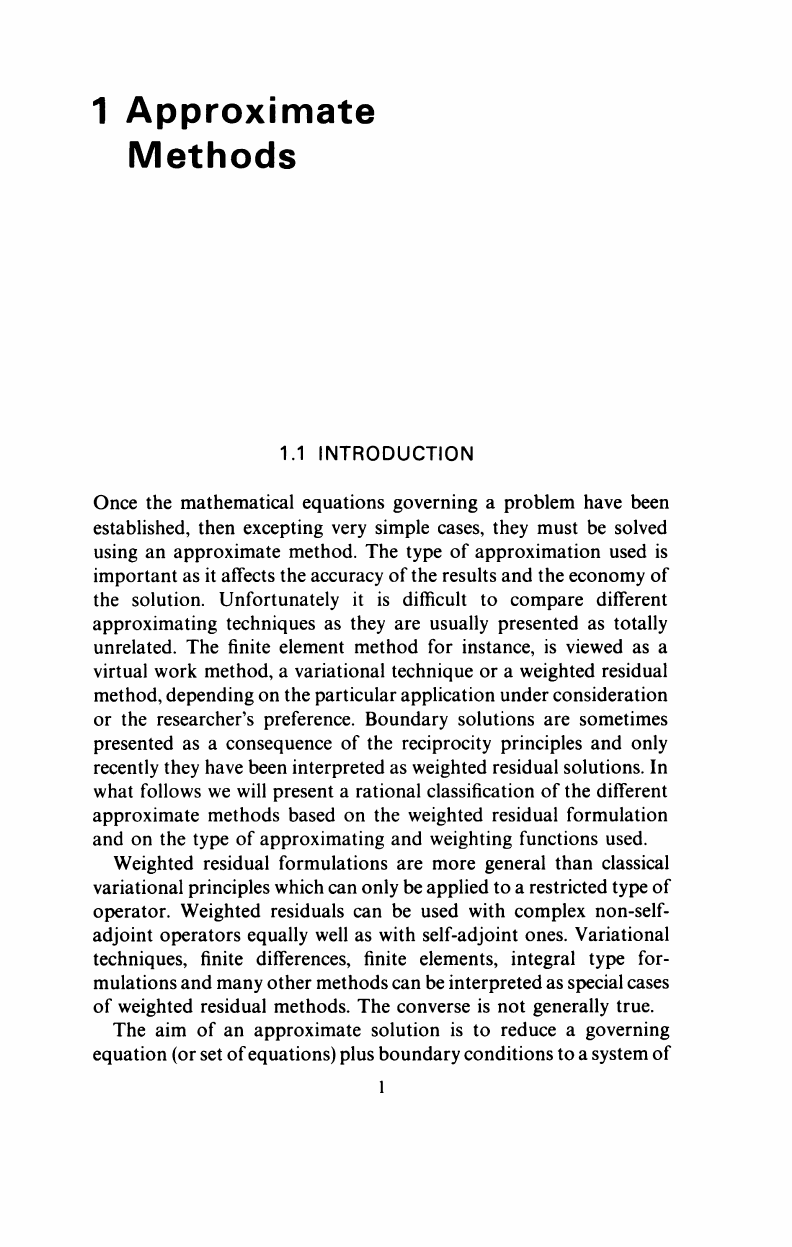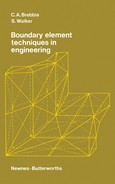
1 Approximate
Methods
1.1 INTRODUCTION
Once the mathematical equations governing a problem have been
established, then excepting very simple cases, they must be solved
using an approximate method. The type of approximation used is
important as it affects the accuracy of the results and the economy of
the solution. Unfortunately it is difficult to compare different
approximating techniques as they are usually presented as totally
unrelated. The finite element method for instance, is viewed as a
virtual work method, a variational technique or a weighted residual
method, depending on the particular application under consideration
or the researcher's preference. Boundary solutions are sometimes
presented as a consequence of the reciprocity principles and only
recently they have been interpreted as weighted residual solutions. In
what follows we will present a rational classification of the different
approximate methods based on the weighted residual formulation
and on the type of approximating and weighting functions used.
Weighted residual formulations are more general than classical
variational principles which can only be applied to a restricted type of
operator. Weighted residuals can be used with complex
non-self-
adjoint operators equally well as with self-adjoint ones. Variational
techniques, finite differences, finite elements, integral type for-
mulations and many other methods can be interpreted as special cases
of weighted residual methods. The converse is not generally true.
The aim of an approximate solution is to reduce a governing
equation (or set of equations) plus boundary conditions to a system of
1

2 APPROXIMATE METHODS
algebraic equations. This is usually done by subdividing the con-
tinuum into a number of
cells
or elements and assuming over each of
these a known variation of the approximating and weighting
functions. Consider for instance, an equation such as Laplace's for
simplicity. This equation can be written as,
V
2
M
0
= 0 ίηΩ (1.1)
where u
0
indicates the exact solution and Ω is the domain under
consideration. The corresponding boundary conditions may be of the
following two types:
conditions u
0
= ü on
Γ
γ
(1.2)
conditions q
0
= du
0
/dn = q on Γ
2
where Γ
ί
and Γ
2
are parts of the boundary where one or the other
condition applies. The total boundary is Γ = Γ
χ
+Γ
2
.
The exact solution u
0
can be found only for a few and simple cases
and generally the solution will have to be approximated. This can be
done by using a set of known linearly independent functions φ
ί
and
unknown coefficients
oc
t
or u/. (a, are values of the u functions at
certain points or nodes and a
f
generalised coefficients that are not
nodal values.) In general we will prefer to use the nodal values as they
have a clear physical meaning but when the nodes are not defined we
will use the a's.
Let us write the approximation for u as
Μ = α
101+
α
202+ ··· (1-3)
Introducing this function into (1.1) and (1.2) will produce an error
(excepting the case for which (1.3) is the exact solution, i.e. u
—
w
0
),
such that,
V
2
« ^ 0 in Ω (1.4)
and on the boundary
u —
ΰ φ 0 onf,
(1.5)
q
—
q^O on Γ
2
q = du/dn.
We can now define error functions in the domain and on the
boundary such that,
ε =
ν
2
Μ^0 ίηΩ (1.6)
..................Content has been hidden....................
You can't read the all page of ebook, please click here login for view all page.
